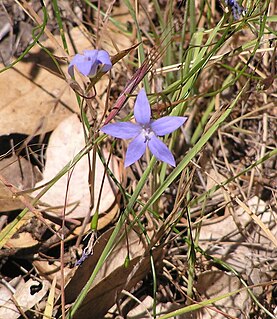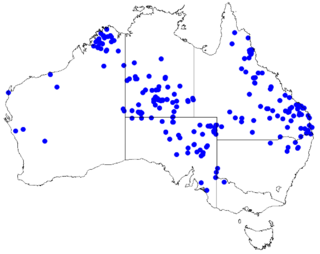
Wahlenbergia gloriosa, commonly known as royal bluebell is a perennial herb in the bluebell family Campanulaceae. It has egg-shaped leaves near the base of its stem, linear leaves higher up and usually a single purple flower with a tube-shaped base. The flower is the floral emblem of the Australian Capital Territory.

Wahlenbergia is a genus of around 260 species of flowering plants in the family Campanulaceae. Plants in this genus are perennial or annual herbs with simple leaves and blue to purple bell-shaped flowers, usually with five petals lobes. Species of Wahlenbergia are found on all continents except North America, and on some isolated islands, but the greatest diversity occurs in the Southern Hemisphere.

Wahlenbergia stricta, the Australian bluebell, tall bluebell or austral bluebell, is an Australian wildflower from the Campanulaceae family. It is considered the most commonly encountered of the Wahlenbergias. It is found in all Australian states but not the Northern Territory. It is often seen growing by the side of the road, enjoying the extra runoff.

Wahlenbergia gracilis, common name Australian bluebell, is an Asian wildflower from the family Campanulaceae. It also grows on western Pacific Ocean islands.
Verticordia luteola is a flowering plant in the myrtle family Myrtaceae, and is endemic to the south-west of Western Australia. It is a more or less openly branched shrub with crowded leaves on its side branches and spikes of pale yellow or bright pink flowers which turn cream to brownish as they age. This verticordia is a summer-flowering species.

Vigna luteola, commonly known as the hairy cowpea and the Nile bean, is a perennial vine found in many tropical areas.

Wahlenbergia capillaris, commonly known as tufted bluebell, is a plant in the family Campanulaceae and is native to Australia and New Guinea. It is an erect perennial herb with a few to many stems and grows to a height of 50 cm (20 in). The leaves are mostly linear with a few scattered teeth on the sides and the flowers are blue, bell-shaped with five lobes and arranged in cymes. This bluebell is widespread and common, occurring in all Australian mainland states and territories.
Wahlenbergia multicaulis is a small herbaceous plant in the family Campanulaceae native to Australia.
Wahlenbergia preissii is a small herbaceous plant in the family Campanulaceae native to Western Australia.

Wahlenbergia queenslandica is a small herbaceous plant in the family Campanulaceae native to Western Australia, to New South Wales, Queensland, the Northern Territory, and South Australia.
Wahlenbergia aridicola is a small herbaceous plant in the family Campanulaceae native to eastern Australia.
Wahlenbergia fluminalis, commonly known as the river bluebell, is a small herbaceous plant in the family Campanulaceae native to eastern Australia.
Wahlenbergia densifolia, commonly known as the fairy bluebell, is a small herbaceous plant in the family Campanulaceae native to eastern Australia.
Wahlenbergia graniticola, commonly known as the granite bluebell, is a herbaceous plant in the family Campanulaceae native to eastern Australia.
Wahlenbergia glabra is a small herbaceous plant in the family Campanulaceae native to eastern Australia.
Wahlenbergia planiflora, commonly known as flat bluebell, is a small herbaceous plant in the family Campanulaceae native to eastern Australia.

Wahlenbergia scopulicola is a herbaceous plant in the family Campanulaceae native to eastern Australia.
Wahlenbergia victoriensis is a herbaceous plant in the family Campanulaceae native to eastern Australia.

Wahlenbergia capensis, commonly known as the Cape bluebell, is a plant in the family Campanulaceae and is native to the Cape Province but has been introduced to Australia. It is an annual herb with up to four greenish blue, bell-shaped flowers with spreading petal lobes.

Roger Charles Carolin is a botanist, pteridologist and formerly an associate professor at Sydney University. He was appointed as a lecturer in botany at the University of Sydney in 1955 earned a Ph.D from Sydney University in 1962 with a thesis on the floral morphology of the campanales, and retired as an associate professor in 1989.









